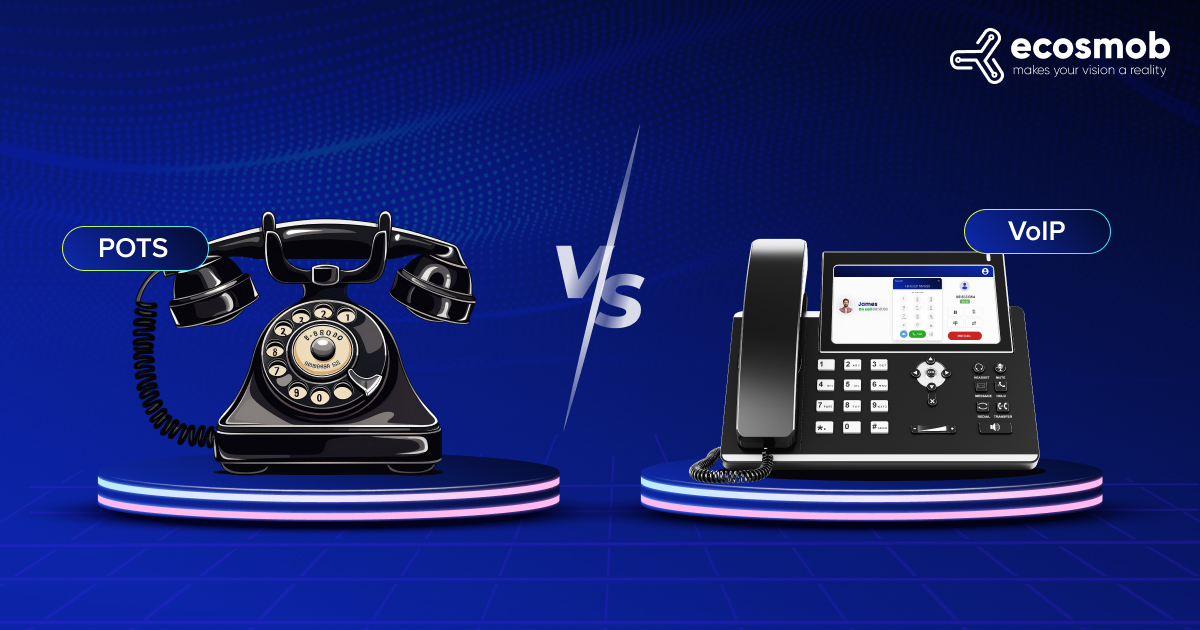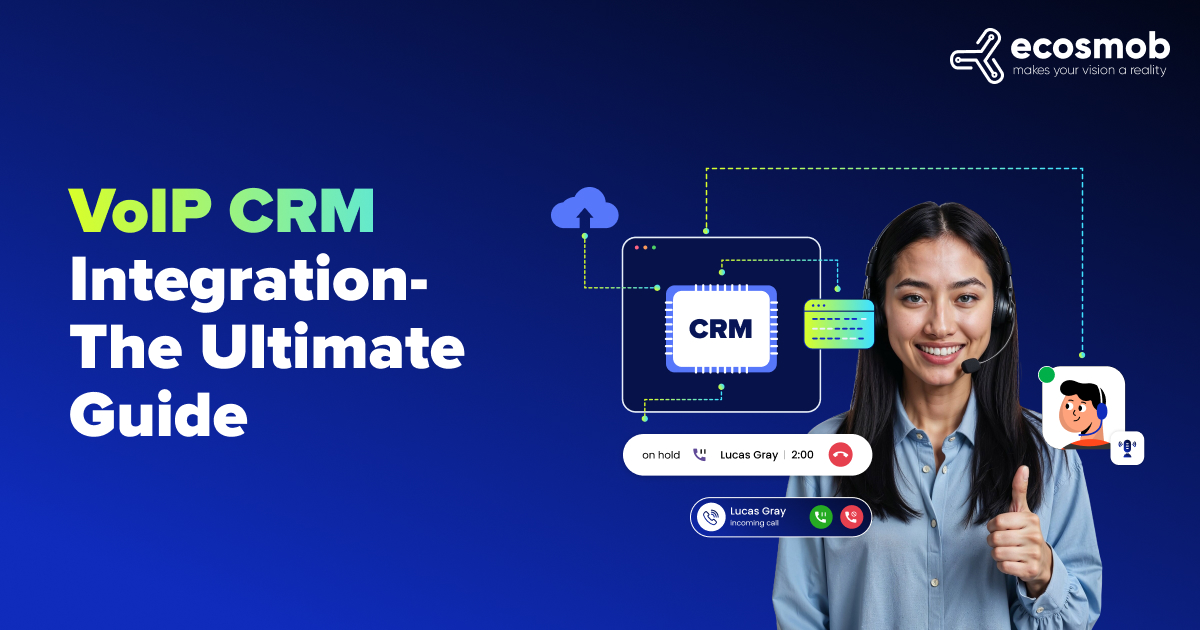QUICK SUMMARY
Cloud telephony leverages VoIP for calls over the internet, reducing costs and hardware needs. It benefits remote teams, integrates with CRM systems, and enhances business communication efficiency
Cloud telephony leverages Voice over IP (VoIP) technology to facilitate phone calls by transmitting your voice over the Internet. With cloud telephony, you can make outbound calls and receive inbound calls using any Internet-connected device, eliminating the need for expensive telephone hardware like IP phones and PBX (Private Branch Exchange) systems.
This innovative phone system is perfect for businesses with remote or frequently off-site staff. Cloud telephony offers numerous benefits, including significantly lower costs than traditional landline services.
In this article, we will explore cloud telephony’s advantages, how it works, and how it enhances business operations.
Switch to cloud telephony now and save up to 50% on your communication costs.
What is Cloud Telephony?
Cloud telephony refers to a system where voice and messaging services are hosted and managed by a third-party provider through the cloud. This setup eliminates the need for businesses to maintain complex and expensive hardware on-premises. Instead, all functionalities are handled by the service provider’s data centers, which are accessible via the Internet.
According to Krispcall, the global VoIP market is expected to reach $194.5 billion by 2024. This growth is driven by the increasing adoption of VoIP services across various sectors.

Cloud-based calling encompasses various services, including virtual phone numbers, IVR systems, call recording, call routing, and more. These services can seamlessly integrate into existing business processes, enhancing communication efficiency and customer experience.
How Does Cloud Telephony Work?
The operation of cloud telephony involves several key components that work together to provide seamless and efficient communication services:
- Hosted PBX (Private Branch Exchange): The heart of cloud telephony, a hosted PBX, manages the routing and switching of calls between users. Unlike traditional PBX systems, hosted PBX is managed by the service provider, reducing businesses’ maintenance and operational costs.
- Internet Connectivity: Cloud telephony relies on internet connectivity to transmit voice and data. A high-speed and stable internet connection ensures clear and uninterrupted communication.
- VoIP: VoIP technology converts voice signals into digital packets transmitted over the Internet, enabling voice communication without relying on traditional phone lines.
- Cloud Servers: All telephony functionalities, including call management, routing, and storage, are handled by servers located in the cloud. The service provider maintains these servers, ensuring high availability and redundancy.
- User Devices: Users can access cloud telephony services through various devices, including IP phones, softphones, mobile apps, and web browsers. This flexibility allows employees to stay connected from anywhere.
Cloud telephony revolutionizes traditional telephony to provide flexible, scalable, and feature-rich communication solutions. It simplifies voice communications management, reduces costs, and enhances the overall efficiency of business operations.
Integrating Cloud Telephony with CRM Systems: A Step-by-Step Guide
Integrating cloud telephony with Customer Relationship Management (CRM) systems is a powerful way to enhance customer interactions and improve operational efficiency. This integration gives businesses a unified view of customer data, enabling personalized and effective customer service.
Step-by-Step Guide to Integrate Cloud Telephony with CRM Systems
Cloud Telephony integration empowers your company to control client communications throughout sales, significantly boosting client call-to-sale conversion rates. Here’s a detailed guide to help you through the integration process:
Step 1: Choose a Cloud Telephony Provider
Select a cloud telephony provider that offers robust integration capabilities with your CRM system. Ensure the provider supports your specific CRM software, such as Salesforce, HubSpot, and Zoho CRM.
Step 2: Set Up Cloud Telephony Services
Once you have chosen a provider, set up your cloud telephony services. It includes configuring your virtual phone numbers, IVR systems, call routing, and other telephony features. Ensure your internet connection is stable and sufficient bandwidth to support VoIP calls.
Step 3: Configure CRM Integration
Most cloud telephony providers offer integration tools or APIs that facilitate the connection with CRM systems. Follow the provider’s documentation to configure the integration. It typically involves:
- API Keys and Authentication: Obtain the necessary API keys or credentials from your cloud telephony provider. These keys must establish a secure connection between the telephony system and the CRM.
- Mapping Fields: Map the relevant fields between the telephony system and the CRM. It includes fields such as phone numbers, call logs, call recordings, and customer details.
- Set Up Triggers and Actions: Define triggers and actions for the integration. For example, you can set up triggers to automatically create a new contact in the Customer Relationship Management when a call is received or log call details under existing customer records.
Step 4: Test the Integration
Before going live, thoroughly test the integration to ensure data is correctly transferred between the cloud telephony system and the CRM. Conduct test calls and verify that call logs, recordings, and customer information are accurately captured in the CRM.
Step 5: Train Your Team
Provide training to your team on how to use the integrated system. Ensure they understand how to access call logs, listen to call recordings, and update customer records in the CRM. Training will help maximize the benefits of the integration and improve customer service.
Step 6: Monitor and Optimize
After the integration is live, continuously monitor its performance and gather feedback from your team. Use the reporting tools and analytics offered by the cloud telephony system to gain insights into call volume, call duration, and customer interactions. Based on these insights, optimize the integration to enhance efficiency and customer satisfaction.
Benefits of Cloud Telephony CRM Integration
Cloud telephony offers numerous advantages over traditional phone systems, making it an attractive option for businesses of all sizes. Here are the several key benefits of integrating cloud telephony with CRM systems:
- Unified Customer View: Integration provides a comprehensive view of customer interactions, including call history, recordings, and notes. It enables personalized and informed customer service.
- Improved Efficiency: Automated logging of call details in the CRM reduces manual data entry, saving time and minimizing errors. Employees can focus on meaningful customer interactions.
- Enhanced Customer Service: Access to call recordings and interaction history allows customer service representatives to understand customer needs better and provide timely solutions.
- Data-Driven Insights: Integration enables businesses to analyze call data and gain insights into customer behavior, call volume patterns, and agent performance. These insights inform strategic decisions and process improvements.
- Streamlined Workflows: Automated workflows triggered by calls, such as creating new leads or updating contact information, streamline processes, and ensure that customer data is always up to date.
Adopting cloud telephony can significantly enhance a business’s communication and make it a valuable asset for modern businesses aiming to stay competitive.
10 Things You Need to Know About Cloud Telephony Before Making the Switch
Before transitioning to cloud telephony, it’s essential to consider various factors to make sure a smooth and successful implementation. Here are vital aspects to consider:
1. Assess Your Business Needs
Understand your business’s communication requirements and how cloud telephony can address them. Consider factors such as call volume, the need for advanced features (e.g., IVR, call recording), and integration with existing systems.
2. Evaluate Service Providers
Research and compare cloud telephony providers based on their offerings, pricing, reliability, and customer support. Look for providers with a strong reputation and positive reviews from other businesses.
3. Internet Connectivity
Make sure that your internet connection is robust enough to support VoIP calls. A high-speed and stable internet connection is crucial for clear and uninterrupted communication. Consider implementing Quality of Service (QoS) measures to prioritize voice traffic.
4. Security and Compliance
Verify that the cloud telephony provider complies with industry standards and regulations concerning data security and privacy. Ensure the provider offers encryption, secure data storage, and compliance with relevant regulations (e.g., GDPR, HIPAA).
5. Integration Capabilities
Check if the cloud telephone service provider supports integration with your existing business applications, such as helpdesk software, CRM systems, and collaboration tools. Integration enhances productivity and streamlines workflows.
6. Scalability
Choose a provider that can grow with your business. Ensure that the cloud telephony solution can accommodate your growing needs, whether you are expanding your team or adding new features.
7. Training and Support
Ensure that the service provider provides comprehensive training and support for your team. Proper training will help employees use the new system effectively and leverage its features to improve communication and customer service.
8. Cost Considerations
Understand the pricing structure of the cloud telephony solution. Compare the costs of several plans and evaluate the value they offer. Consider both the initial setup costs and ongoing subscription fees.
9. Migration Plan
Develop a detailed migration plan to transition from your phone system to cloud telephony. This plan should include steps for data migration, user training, and testing to minimize disruptions during the switch.
10. Customer Support
Ensure that the cloud telephony provider offers reliable customer support. Access to timely assistance is crucial for resolving any issues arising during and after the implementation.
Maximizing Business Efficiency with Cloud Telephony
Cloud telephony is a transformative technology that offers numerous benefits for businesses. By leveraging internet-based voice communication, companies can reduce costs, enhance flexibility, and improve customer service. Integrating cloud telephony with CRM systems further amplifies these benefits, providing a unified view of customer interactions and streamlining workflows.
Before switching to cloud telephony, businesses should carefully evaluate their needs, choose a reputable provider like Ecosmob Technologies, ensure robust internet connectivity, and develop a comprehensive migration plan. With the right approach, cloud telephony can significantly enhance communication efficiency and support business growth.
Empower your business communications and start with a 25-day free software development service.
FAQs
What is Cloud Telephony?
Cloud telephony, or cloud calling, is a communication system where all the telephony functions are managed in the cloud. It means that internet-based phone services are replacing traditional telephone systems, allowing for more flexible and scalable communication solutions.
How does Cloud Telephony work?
Cloud telephony operates through VoIP (Voice over Internet Protocol) technology. Calls are made and received over the Internet rather than traditional phone lines. Cloud telephony CRM systems integrate seamlessly with existing CRM platforms to enhance communication efficiency.
What are the benefits of Cloud Telephony for my business?
Cloud telephony benefits include cost savings, scalability, flexibility, and enhanced features such as automated call distribution, interactive voice response (IVR), and integration with other business tools. Cloud-based calling solutions also offer better disaster recovery and business continuity.
Can Cloud Telephony integrate with other business tools?
Yes, cloud telephony integration is one of its key advantages. It can be integrated with various business tools such as CRM systems, email marketing platforms, and other productivity tools, improving overall business communication and customer service.
Is Cloud Telephony secure?
Yes, cloud telephony providers implement robust security measures to protect your data and communications. These include encryption, secure data centers, and compliance with industry standards to make sure the confidentiality and integrity of your business communications.















